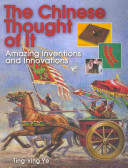
How Chinese ingenuity changed the world. Acupuncture, gunpowder and the secrets to spinning silk are innovations that we have come to associate with China. But did you know that the Chinese also invented the umbrella? And toilet paper, initially made from rice straw clumped together, was first used in China! Through the ages, the Chinese have used the resources available to them to improve their lives. Their development of the compass and the paddleboat helped facilitate the often difficult tasks of travel and trade, and many foods associated with health and wellness — from green tea to tofu — have their origins in China. Other interesting innovations include: the suspension bridge and the wheelbarrow playing cards. With descriptive photos and information-packed text divided into sections including farming, food and games, this third book in the “We Thought of It” series explores the fascinating origins of much that surrounds us today.






